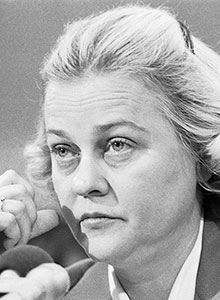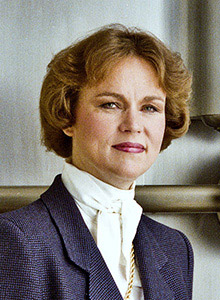Diversity and inclusion are critical to the effectiveness and functionality of the Federal Reserve System. Since its establishment in 1913, women have made significant contributions to the Fed at all levels of the organization. In honor of Women’s History Month, here are the stories of two women leaders who broke the glass ceiling and made history at the Federal Reserve.
Nancy H. Teeters: First Woman to Serve on the Federal Reserve Board of Governors

Nancy H. Teeters was born in Indiana and obtained a bachelor’s degree in economics in 1952, followed by a master’s degree in economics in 1954. Throughout Teeters' long-standing career, she supported the Federal Reserve and U.S. government in many different roles, including:
- 1957-1966: Economist on the Federal Reserve Board’s Division of Research and Statistics
- 1962-1963: Economist on the President’s Council of Economic Advisers
- 1966-1970: Fiscal Economist with the Planning and Analysis Staff of the Bureau of the Budget (now known as the Office of Management and Budget)
- 1974-1978: Assistant Staff Director and Chief Economist for the Committee on the Budget of the U.S. House of Representatives
- 1978-1984: Governor on the Federal Reserve Board of Governors
When Teeters joined the Board of Governors, the nation was in a period of high inflation rates and her work helped stabilize the economy. Teeters was known for being unafraid to disagree with the Chairman of the Fed and the majority of the board while advocating for economic policies (Off-site). Along with her contributions to the U.S. economy at the Federal Reserve, Teeters co-authored publications on the U.S. budget, Social Security taxation, employment and other economic topics.
Read Nancy H. Teeters’ full bio (Off-site)
Karen N. Horn: First Woman to Serve as a Federal Reserve Bank President

Karen N. Horn was born in California and received a bachelor’s degree in mathematics in 1965, followed by a doctorate in economics in 1971. Horn held positions in both the public and private sectors throughout her career. Her notable responsibilities at the Federal Reserve included:
- 1969-1971: Senior Economist on the Federal Reserve’s Board of Governors
- 1982-1987: President of the Federal Reserve Bank of Cleveland
Horn was dedicated to the mission of the Federal Reserve and was a strong proponent of anti-inflationary monetary policy. During her presidency, she successfully guided the Federal Reserve Bank of Cleveland through Ohio’s savings and loan industry crisis (Off-site), which was fueled by rising interest rates.
Read Karen N. Horn’s full bio (Off-site)
To learn more about the women who helped build the Federal Reserve System we know today, along with other essays on topics that include the Fed’s purpose and functions, visit federalreservehistory.org (Off-site).

